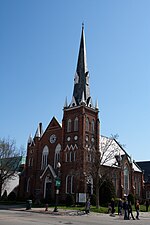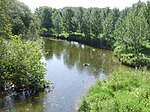Oakville GO Station

Oakville GO Station is a GO Transit railway station and bus station in Oakville, Ontario, Canada. It is colocated and shares platforms with Via Rail's Oakville railway station. It is a stop on GO's Lakeshore West line train service and, until October 2007, served as the western terminus for weekend service. On weekdays, one branch of the Highway 407 GO bus service, that connects with Sheridan College, Square One Bus Terminal, Bramalea GO Station, and Highway 407 Bus Terminal terminates at this station. Apart from Union Station, Oakville is the busiest station in GO Transit's network by passenger volume.It is served by Via Corridor intercity routes between Windsor and Toronto, and the joint Amtrak–Via Maple Leaf service between New York City and Toronto.
Excerpt from the Wikipedia article Oakville GO Station (License: CC BY-SA 3.0, Authors, Images).Oakville GO Station
GO Bus Loop, Oakville
Geographical coordinates (GPS) Address Nearby Places Show on map
Geographical coordinates (GPS)
| Latitude | Longitude |
|---|---|
| N 43.455 ° | E -79.6825 ° |
Address
GO Bus Loop
L6J 3J1 Oakville
Ontario, Canada
Open on Google Maps




